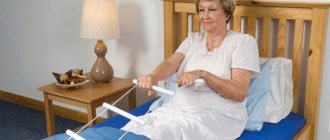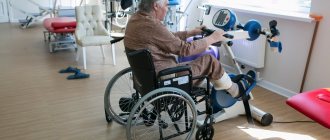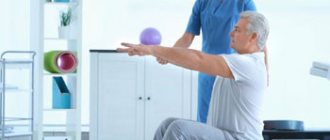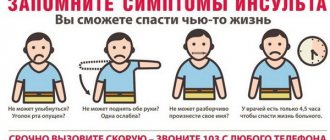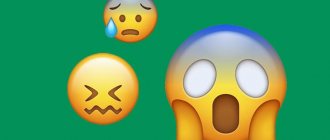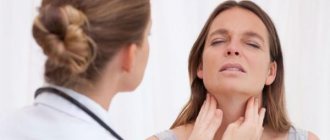Stroke is a serious brain disease characterized by circulatory disorders, focal lesions of brain tissue, and death of neurons. A stroke can be hemorrhagic or ischemic. Hemorrhagic stroke is less common than ischemic stroke and is characterized by rupture of blood vessels and hemorrhage in brain tissue. Ischemic stroke is more often diagnosed in older people and is characterized by impaired blood flow in the cerebral arteries and the death of neurons in the area of blood supply to brain tissue by the affected artery. When a stroke develops, the patient requires emergency care: the sooner the patient is admitted to the hospital, the more effective the care provided by doctors will be.
In addition to drug treatment of stroke, great importance is attached to rehabilitation therapy, which begins to be carried out in the acute period of the disease. At the Yusupov Hospital, various methods of physiotherapy and exercise therapy are used to restore patients after a heart attack and stroke. With the help of a comprehensive rehabilitation program, the patient is rehabilitated - restoration of motor activity, coordination of movements, visual function, sensitivity. The neurorehabilitation department of the hospital is equipped with modern devices, verticalizers and various simulators, including robotic ones.
The influence of exercise therapy on the patient’s nervous system
Therapeutic exercise is the performance of certain physical exercises, which begin with the simplest movements of the patient after he regains consciousness, then the physical activity gradually increases, the exercises become more complex. Exercise therapy helps improve blood circulation in organs and tissues, accelerates the process of restoration of various body functions, and improves metabolism. Physical therapy exercises for each patient are selected individually depending on the severity of the patient’s condition and concomitant diseases. An individual physical therapy program at the Yusupov Hospital is drawn up by a rehabilitation doctor.
Make an appointment
Sports after a stroke. Prohibition or necessity?
Strokes are diseases that are getting younger every year. Lethal outcomes are possible, but most often, a person survives the attack, however, he may remain disabled. However, there are many well-known cases of complete recovery of people who have suffered strokes and returned to an active lifestyle. The key role in this issue is played by the positive attitude of such patients and early rehabilitation.
The first month after a stroke is the most important.
It is at this moment, when the patient is in the intensive care unit, that it is necessary to completely restore cerebral circulation, the rheological properties of the blood, and eliminate the possibility of hypoxia, using appropriate medications under the strict supervision of doctors.
Particular attention is paid to the use of antioxidants and antihypoxants of combined action, with antioxidant, nootropic and anxiolytic properties, for example, ethylmethylhydroxypyridine succinate (Mexidol), which gives good results when used in the recovery period in patients who have suffered a stroke.
A set of physical exercises is the second stage of recovery measures.
Its importance is difficult to overestimate, because, in many ways, it is thanks to regular physical activity that muscle recovery occurs.
Such patients need to relearn how to walk, eat, run, feel and control their body.
That, no matter how specially selected a set of exercises, will help achieve excellent results in restoring the body.
It is important to remember that you should not sharply load the muscles.
All exercises must be performed gradually, but constantly, because without a systematic approach success cannot be achieved.
Physical activity for such patients should be selected by a medical specialist to avoid the possibility of injury to muscles that have been at rest for a long time.
The patient should perform complex exercises under supervision; after numerous training sessions, the patient can perform light manipulations independently.
In general, the impact of sports exercises on the patient’s recovery process after a stroke is positive.
Blood circulation, trophism and oxygen delivery to organs and tissues, including the brain, improves. The muscles are developed and the possibility of their atrophy is eliminated.
A positive effect is also an improvement in the mood of such patients, which is noted when performing physical exercises and spending time in the fresh air. But, as mentioned above, you cannot overload the body. The muscles and surrounding tissues were at rest for a long time.
Increased physical activity will not bring positive effects, but vice versa.
The risk of injury increases, and the mood of such patients falls due to a feeling of helplessness. It is imperative to convey to the patient that previous physical activity can cause serious harm to him. That is why it is important to maintain balance in everything related to the recovery of stroke patients.
Thus, medication support under the supervision of a doctor, moderate physical activity - all this helps in combating the consequences of a stroke. It is possible and necessary to fight it. Right now.
Passive and active rehabilitation after stroke
The first classes with the patient are conducted by a physical therapy instructor in the ward. The patient performs simple movements with his arms and legs with the help of an instructor - this type of rehabilitation is called passive. Passive rehabilitation of the upper and lower extremities begins with the development of large joints with a gradual transition to small joints. Rehabilitation therapy begins with the shoulder and hip joints. After developing the hip joint, the instructor helps the patient flex and extend the lower limb, develops the knee, then the ankle joint, and lastly the doctor develops the joints of the foot.
The rehabilitation specialist performs massage from the foot to the thigh. During hand rehabilitation, exercises begin with the development of the shoulder joint, then flexion-extension and rotational movements of the hands are carried out in the area of the elbow and hand joints. Massage of the upper limbs is performed from the fingers to the shoulder. A set of exercises combined with massage stimulates brain function. With partial restoration of motor function, exercise therapy exercises become more complex, and the patient begins to perform the exercises independently. The time for gymnastics increases from 10 minutes to half an hour, and active rehabilitation of the patient begins.
If the brain damage is significant, the patient is paralyzed, sensitivity is lost, rehabilitation is carried out with the help of medication, massage, electromagnetic stimulation of nerve cells, acupuncture, and reflexology. After partial restoration of motor function, the rehabilitation doctor introduces therapeutic exercises into the program.
When to start rehabilitation
The goal of rehabilitation is to restore brain functions damaged by a stroke. This is achieved by forming new neural connections. Physical activity is one of the main ways to stimulate recovery processes. You should not delay the start of rehabilitation measures. You can perform feasible exercises already in the first days after a stroke.
The rehabilitation period is the first 12 months after acute cerebrovascular accident. But even after this time, when the process of formation of neural connections slows down, it makes sense to continue doing therapeutic exercises and sports.
The exact date for the start of rehabilitation, its duration, intensity and types of physical activity are determined by the attending physician. This depends on the extent and depth of brain damage, as well as on the course of the disease, the speed of recovery and the presence of other diseases.
✓ Complete immobility
If after a stroke a person has completely lost the mobility of his limbs, he will need outside help to perform simple exercises. You need to regularly move your arms and legs to prevent blockage of veins, bedsores, and congestion.
✓ Minimal mobility
If the patient has minimal mobility, the training consists of rotating the eye muscles and head, finger movements, and breathing exercises.
✓ Partial mobility
In this case, exercises are prescribed to help restore coordination of movements so that the patient can stand and walk. Gradually introduce arm/leg raises, torso bends, squats, and limb swings.
It is important to remember: the exercises are performed slowly, smoothly, carefully. You should not shorten or increase the time of exercise on your own, or add new movements without the consent of your doctor. The average training time at first is no more than 30 minutes.
Rehabilitation exercises on simulators
The Yusupov Hospital uses two types of simulators for the rehabilitation of patients after a stroke - mechanical and robotic. Mechanical exercise machines include exercise bikes, treadmills, and exercise machines for restoring balance and gait. Robotic simulators are equipped with electronic biosensors that stimulate activity by influencing the affected limbs. Robotic simulators have wide functionality; they are programmed taking into account the patient’s needs, promote the transmission of nerve impulses from the brain to the injured limb, and stimulate motor activity.
Rehabilitation exercises after a stroke are performed using multifunctional exercise equipment and sports equipment. There are different types of simulators:
- To restore motor activity, use a flexion/extension simulator, a simulator for developing the joints of the limbs, exercise tracks, and exercise bikes.
- For bedridden patients, exercise equipment in the form of a bed or bicycle is used.
- To restore balance, gait, and motor activity, a horizontal simulator is used.
- For patients who cannot yet stand, a seated exercise machine has been created to develop and strengthen the back muscles.
Hand exercises for stroke rehabilitation
Hand exercises improve motor activity and help restore lost functions. In severe cases and in the absence of early rehabilitation, hand functions are often not restored or partially restored. In some cases, rehabilitation does not help; doctors carry out bipolar stimulation - an effect on immobile joints and muscles of the body using artificially created impulses from the brain to the body. This helps restore reflexes and sensitivity, improve blood circulation in the tissues. Then the patient undergoes rehabilitation using exercise therapy and other methods.
The motor activity of the hands and the motor skills of the fingers are most difficult to restore. You can often see trembling hands in a patient after a stroke; he cannot hold a ballpoint pen in his hand, cannot write, and does not grasp objects well. Especially for such patients, they conduct classes in modeling from plasticine, with a Rubik's cube, teach them to write again, and work on a silicone simulator. Doctors use reflexology if a patient has suffered a severe stroke. This helps restore fine motor skills, improve grasping movements, flexion and extension of fingers, and joints of the hand. At the Yusupov Hospital, patients undergo rehabilitation on computerized simulators using a comprehensive recovery program, which includes massage and physical therapy exercises.
Hand exercises are not complicated and do not require special exercise equipment or devices; the patient can perform them at home:
- Lie on the bed, move your arms back and grab the headboard. Tighten the muscles of your arms and body, imitating a pull-up. Raise your legs up or stretch them straight.
- Using rotational movements of bent arms, knead the shoulder joint.
- Sit upright on the bed, place your hands behind your back as close to each other as possible, tilt your head back, then return to your previous position.
Rehabilitation after a stroke. 7 questions for a specialist
Meanwhile, there are already a lot of modern technologies that, in many cases, allow even very sick patients to return to normal life.
When to start rehabilitation after a stroke
My father had a stroke two months ago. When can you start rehabilitation?
It should have started yesterday! But it’s not too late - after a stroke, rehabilitation measures are effective only if they begin no later than three months from the moment of the vascular accident. Unfortunately, after this period, many functions can no longer be restored.
If rehabilitation is started immediately after a stroke, up to 70% of lost functions can be restored.
What modern technologies for recovery after stroke exist today?
After a stroke, spinal injuries, or traumatic brain injuries, many patients have to learn to get up and walk again. And today there are special smart simulators equipped with biofeedback systems (BFB). They help restore fine motor skills of the hands, motor functions, and teach them to walk. For example, in our center we have a simulator in the form of a fragment of a staircase with the ability to adjust the height of the steps. It can be adjusted to the individual needs of a particular patient.
Exercise machines equipped with biofeedback systems help adapt to the patient - reduce the resistance of the system in response to human movements, or, on the contrary, increase it. This way you can develop the upper limbs of the arm (including during a computer game, when a person is asked to control an analogue joystick), legs (a computer simulator helps the patient move), and back muscles.
It is very important that a person sees himself in the mirror. Even when a robotic simulator walks for him, the patient thinks that he himself is moving. Thus, using the plasticity of the nervous system, we are trying to deceive the brain, which is what the principle of “mirror therapy” is based on. Let’s say a person has one arm that doesn’t move after a stroke.
There is a very simple exercise machine in the form of a wooden box with a mirror partition. The hands are placed in two sections, but the patient sees only the working one, which is reflected in the mirror. Thus, it seems to him that both hands are moving. The brain thinks so too - and it begins to send impulses along the nerve endings. In this way, motor activity begins to slowly recover after a stroke.
Training and fitness after a stroke
Is it possible to do strength training in fitness centers after a stroke?
I would not recommend dumbbells to anyone at all. They give weight, which leads to tendon damage. An ideal replacement is rubber expander bands, which allow you to train muscles with different loads. They are absolutely safe, their use does not lead to injury. Our patients exercise under cardiac control.
Are there any domestic developments for the rehabilitation of patients after strokes and severe injuries?
Our programmers have developed the ITilect computer program, which, in principle, can be installed on any Western game console. The program projects “virtual reality” and the patient’s avatar onto the walls and floor of the room. Depending on the situation, various action scenarios are proposed. For example, hit balls, try to feed the dog, walk on the rocky seabed. At the same time, the doctor can control whether the patient performs such exercises at home: he has access to remote reports generated by the system.
What problem should patients and their relatives pay special attention to?
Often after a stroke, a person loses the ability to control the pelvic floor muscles and the functions of the pelvic organs, that is, they begin to go to the toilet under themselves. This is much more difficult to survive than even the fact that an arm or leg is paralyzed. Therefore, pelvic floor rehabilitation is very important. Special modern simulators can restore its functions.
Seasonality of strokes
What time of year does stroke occur most often?
There is a phenomenon of Russian dacha stroke that does not exist anywhere else in the world. Grandma lives in the city for nine months—that’s how long our winter lasts. And then she is taken to the dacha (a tradition that does not exist anywhere else in the world), where her wings grow and her joint pain goes away. And she rushes to the garden bed, spending the whole day with her head down, to which the blood rushes.
In addition, we do not have a culture of drinking clean water, which helps thin the blood, so at some point my grandmother also becomes dehydrated. That is, ideal conditions are created for the formation of a blood clot in the head. As a result, one half of the body is taken away in the morning.
Rehabilitation after stroke - manual therapy
Is it possible to perform manual therapy on patients after a stroke? There is an opinion that incorrect actions of chiropractors, on the contrary, can lead to vascular accidents.
The main rule is that you cannot do manual therapy without conducting a preliminary diagnosis. If there are no contraindications, this method helps to restore lost functions after a stroke; osteopathic techniques and methods of traditional oriental medicine also have a great influence on recovery.
In the rehabilitation process, the main thing is the continuity of treatment and coordinated work of multidisciplinary teams of specialists - neurologists, orthopedists, chiropractors, physical therapy doctors, as well as psychotherapists and neuropsychologists.
For the shoulder joint
Restoration of the forearm and shoulder joint takes place with the help of flexion and extension exercises, rotation, push-ups, muscle tension and relaxation, clapping, and massage. To do this, use exercise machines, dumbbells, and various devices. First, the arm is kneaded, then a set of exercises is performed; therapeutic exercises are always combined with a massage of the limbs. A set of exercises for the shoulder joint:
- The patient lies on his back, arms extended along the body. The instructor holds his hand at the elbow to avoid bending, takes the patient's palm with his other hand and moves the patient's arm up and down.
- The instructor performs circular movements with the patient's arm fixed in a straightened state.
- The patient lies on his back, with his arm slightly to the side. The instructor turns the straightened arm over, palm down, then up.
For lower limbs
Exercises for the lower extremities begin to be performed as soon as the patient regains consciousness. At the initial stage, the instructor helps to bend and straighten the lower limbs; over time, the patient will be able to imitate walking in a prone position, then get out of bed, learn to maintain balance, and walk without support. Exercises for patients in the supine position:
- The patient is in a supine position, the leg is straightened. The instructor turns the leg with the foot inward, then outward.
- The patient is in a supine position, the leg is bent at the knee. Holding one hand under the knee, the instructor performs circular movements with the limb, holding and pressing with the other hand in the hip joint area.
- The patient is in a supine position, the affected leg is bent at the knee. The instructor fixes the leg at a right angle, holding it with the other hand under the knee, bends and straightens the lower limb.
- The patient is in the same position on his back, with the leg fixed at a right angle. The instructor, holding the patient's leg under the knee, moves it away from the body and returns it back.
These exercises are performed by the patient after he is allowed to sit:
- In a half-sitting position, holding the edges of the bed with both hands, stretch both legs forward as evenly as possible, bend over, throwing your head back. While stretching your limbs, take a deep breath, return to your previous position and exhale.
- Remain in the same body position, keep your breathing calm and deep, slowly lift your right leg up and lower it back, then your left leg.
- In a half-sitting position, bend your leg, pull your bent leg at the knee as close to your chest as possible (you can help with your hands), and tilt your head forward during the exercise. Bending the leg, inhale, straightening the limb, exhale, return to the previous position.
Exercise therapy to restore visual function after stroke
At the Yusupov Hospital, patients with visual impairments will be able to undergo examination, treatment, rehabilitation, and, if necessary, surgical treatment in a network of partner clinics. Rehabilitation after a stroke includes exercises that you can then do at home. Depending on the type of visual impairment, rehabilitation therapy is carried out:
- If lateral vision is impaired, intensive medical and restorative treatment is carried out, undamaged areas of the cerebral cortex take over the lost function, and vision is restored. In this case, the doctor marks with a red line a passage of text on the page of the book on the side of which lateral vision is weakened. Before starting to read, the patient must look for the red line - this will be the beginning of the text.
- With oculomotor nerve palsy, the patient cannot look straight and his eyes look in different directions. Such a disorder can resolve over time with proper and timely treatment and rehabilitation. With paresis of the oculomotor nerve, accommodation may be impaired. Over time, the patient gets used to using only central vision. To determine the impairment of perception of objects at far and near distances, the following test is performed: the doctor takes a pencil in each hand and brings one of the pencils closer to the patient’s face, then moves his hand back.
- If atrophy of the oculomotor nerve develops, the patient's function of the upper eyelid muscle is impaired. Nystagmus or trembling of the eyeballs may occur. Often this condition leads to visual impairment.
To restore vision, the doctor asks the patient to draw the other half of an object in a drawing or take part in a certain type of computer game. The patient is asked to follow with his gaze the pencil in the doctor’s hand, which moves in front of the patient’s face to the right, then to the left, up or down. The patient should follow the pencil without turning his head. To improve blood circulation, eye massage is necessary and beneficial. The eyes are closed, with gentle movements in a circle the patient massages the eyeballs, lightly pressing on them. The exercise should be performed for 10-20 seconds.
To restore visual function, a number of eye exercises are performed:
- Rotate the eye to the right, then to the left - repeat several times.
- Look up, then down - repeat the movement several times.
- Movement of the eyes in a circle - to the right, then to the left.
- Take a short break with your eyes closed, open your eyes and blink frequently for a few seconds.
- Close your eyes tightly and relax - repeat several times.
- Fix your eye on the object, then turn your head to the right and left without taking your eyes off the object - do this several times.
Prevention of recurrent stroke
Having experienced a cerebrovascular accident, a person first thinks about the main thing - I survived. The danger passed by. Even if there are consequences and impaired movement or speech, the main idea is that now everything is over, the worst is over. Few people think that a stroke can happen again. And this, unfortunately, is reality.
The share of recurrent strokes accounts for up to a third of their total number, and according to statistics continues to increase.
The risk of recurrent stroke is highest in the first year.
Having suffered a stroke means that, along with restorative treatment and rehabilitation, it is necessary to remember the risk of a recurrence of the vascular accident. This risk cannot be excluded, but it can be reduced by monitoring your health and following medical recommendations.
What is included in this control? what to pay attention to?
Protection against recurrent stroke will be:
– control of blood pressure by measuring it twice a day, morning and evening, recording it in a self-monitoring diary and carefully, without skipping, taking antihypertensive drugs prescribed by a doctor. If they are poorly tolerated, consult a doctor, but do not cancel them yourself or change the dose.
– careful, without skipping, taking statins and annual blood monitoring for lipid profile
– sugar control and diet if you have diabetes
– carefully take medications prescribed by your doctor to maintain your heart rhythm if atrial fibrillation (atrial fibrillation) has been detected.
– physical activity and diet.
Causes of recurrent stroke
The causes of a second stroke are the same as the first: genetic predisposition to stroke, high cholesterol, which causes atherosclerosis, heart rhythm disturbances, diabetes mellitus. And the first stroke means that now control over your health must become truly strict.
Strict adherence to doctor's prescriptions, taking medications as scheduled, without omissions, constant monitoring of key indicators (pressure measurement, lipid profile, glucose level).
Physical activity is also very important. Move as much as possible after a stroke. Eat wisely and lose weight; obesity is a serious enemy of the heart and blood vessels. All these control measures will not guarantee safety, but will help ensure that the treatment received is effective and quickly detect sharp fluctuations in blood pressure, sugar and heart rate, which are so dangerous. Reducing the risk is in our hands.
Diseases that may lead to a recurrent stroke
The same diseases that led to the first increase the risk of another stroke. This is atherosclerosis with significant narrowing of large vessels, heart rhythm disturbances in the form of atrial fibrillation (atrial fibrillation), diabetes mellitus, and increased blood clotting.
The risk is also higher in overweight people.
It is worth remembering that after the first stroke, these diseases did not disappear, which means the need to monitor your health only increased.
Taking prescribed medications, monitoring blood pressure and sugar, and physical movement are measures to protect against a recurrent stroke. Share
Restoring fine motor skills after stroke
Fine motor skills are restored with the help of simple exercises that allow you to restore fine hand movements and finger flexibility. The most effective activities for restoring fine motor skills are putting together puzzles, various objects from small parts of a construction set, drawing, fastening buttons on clothes, and lacing shoes. To restore the function of the hand and fingers, the patient is asked to take two nuts in his hand and roll them with the movement of the palm and fingers. Recommended for patients after a stroke to develop fine motor skills:
- Sort through the beans and peas, separating the peas from the beans.
- Use special silicone hand trainers with spikes to massage your palms and fingers.
- Tighten and unscrew nuts, close and open the lock with a key, turn on and off the lights in the room, write texts.
To protect yourself from being hit:
Monitor your blood pressure daily. Arterial hypertension is the most significant risk factor for stroke. Therefore, it is important to take all the medications prescribed by your doctor for hypertension regularly, and not occasionally.
Limit alcohol. The risk of stroke in non-drinkers is 4 times lower than in those who abuse alcohol.
Do not smoke. This will halve the risk of problems with the blood vessels of the heart and brain.
Question answer
How to improve speech after a stroke?
Maintain a normal weight and eat rationally. More vegetables and fruits, less fatty, meat and salty foods. The Mediterranean diet is ideal.
Exercise regularly, but without overload. The most useful thing is dynamic loads (swimming, running, walking). 30–40 minutes daily. When playing sports, it is important to monitor your heart rate (maximum value = 220 – age).
Treat diseases that contribute to the development of strokes in a timely manner. First of all, this concerns cardiovascular diseases. Thus, heart failure is the cause of every fifth ischemic stroke, and coronary heart disease doubles its risk. If you have atrial fibrillation, you must regularly take modern blood-thinning medications (anticoagulants) prescribed by your doctor. After all, a huge proportion of ischemic strokes are associated with atrial fibrillation. The risk of stroke is also increased by collagenosis, chlamydia, blood diseases, and diabetes.
Click to enlarge.
Restoring speech after a stroke
Speech function after a stroke is restored much worse than motor function. Its recovery can take a long time, over several years. Speech therapists at the Yusupov Hospital are developing a program and working with the patient to restore speech throughout the entire period of his stay in the hospital; after discharge from the hospital, his relatives are involved in the patient’s rehabilitation. To restore speech, the following techniques are used:
- Pronunciation of an incomplete word - the patient must complete the word independently.
- If speech function is completely lost, rehabilitation begins with the pronunciation of individual sounds.
- When the patient learns to pronounce words, he is forced to repeat short poems and sayings.
- Singing is considered one of the best methods of speech restoration.
- In order for the patient to learn to speak faster, the facial muscles and tongue muscles should be trained. For this purpose, the patient is taught to curl his lips into a tube, stick his tongue out of his mouth as far as possible, and lick his lips with his tongue, first in one direction, then in the other. Lightly bite your lower lip, then your upper lip, and bare your teeth.
Make an appointment
Swimming after a stroke
About 4 months after discharge from the hospital, you can start swimming. It is important to control your heart rate, as well as choose the optimal pace and intensity of movements.
It is extremely difficult to get injured while swimming; people of any weight can swim, and the list of restrictions, in comparison with other types of physical activity, is much shorter:
- hypertensive crisis;
- viral and skin diseases;
- postoperative period;
- arrhythmia.
Benefits of swimming:
- normalization of blood pressure;
- cardiovascular support;
- improved breathing;
- acceleration of metabolism and weight loss;
- increased mood, increased vigor and energy.
The frequency of classes is 2-3 times a week.
Rehabilitation of the patient at home
Before the patient is discharged from the hospital, relatives receive recommendations on caring for the patient after a stroke. Recommendations for rehabilitation will be provided by the attending physician. The rehabilitation exercise program is performed every day without breaks, 2-3 times a day. Performing physical exercises should not tire the patient or cause him pain. Exercises in a sitting position help prepare the patient for walking.
When the condition improves, exercises are performed in a standing position; they help eliminate neurological disorders as much as possible by restoring fine movements. The patient performs exercises with an expander. From a standing position, he bends down and picks up a matchbox from the floor. Performs breathing exercises with raising your arms up while inhaling, standing on your toes, then lowering yourself onto your entire foot, lowering your arms, exhaling, leaning forward. A comprehensive recovery program is aimed at reducing muscle tone, improving blood circulation, preventing joint contracture, restoring and maintaining fine motor skills, speech, preventing the formation of bedsores and the development of inflammatory processes.
The Yusupov Hospital uses modern rehabilitation methods, uses various types of exercise equipment, and physical therapy exercises. Rehabilitation doctors develop an individual rehabilitation program for each patient.
Healthy running in rehabilitation after a stroke
Jogging has a beneficial effect on the cardiovascular system, strengthens joints, starts metabolic processes, improves breathing processes, blood circulation, and increases resistance to colds.
During slow running, the main load falls on the muscles and joints of the legs, abs and back, and partly on the chest, neck and arms. This should be taken into account when drawing up a rehabilitation program.
It is also worth knowing the rule of the four Ps:
- Consistency - choose the route, speed and frequency of training. Try not to break the schedule in order to launch and maintain healing processes in the body.
- Consistency - take breaks between runs (at least a day) to recuperate.
- Gradual - the first run should last no more than 20 minutes. Gradually increase this time.
- Strength - try not to exceed the load so as not to get injured and discourage the desire to run.
